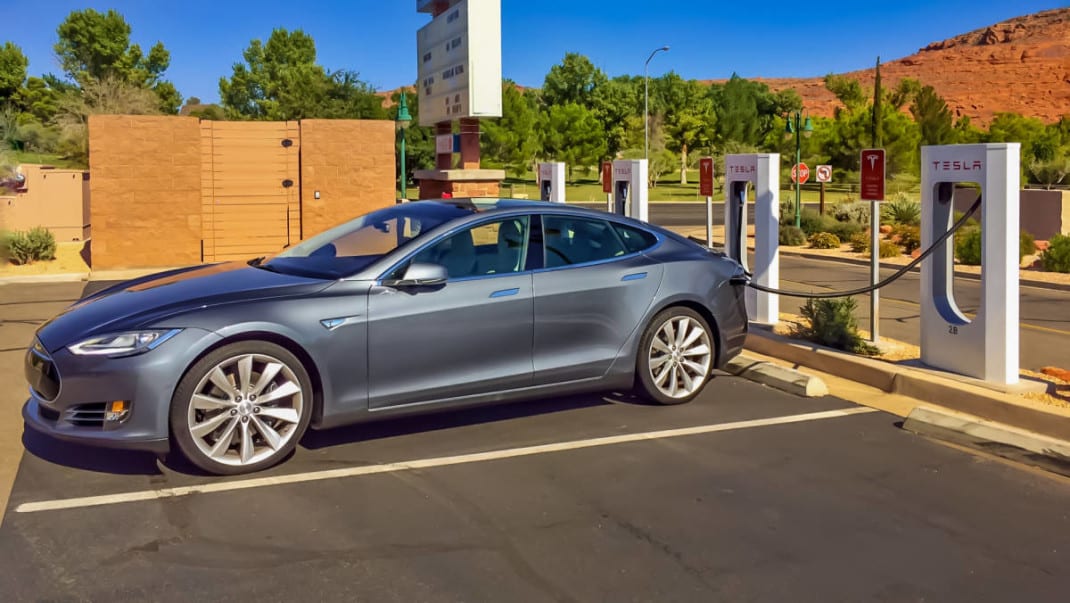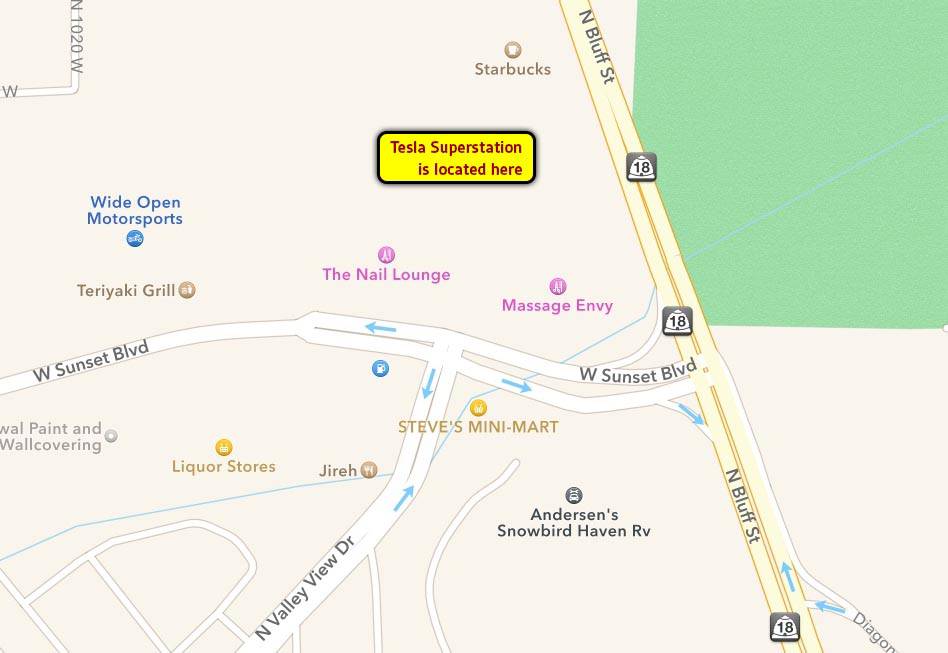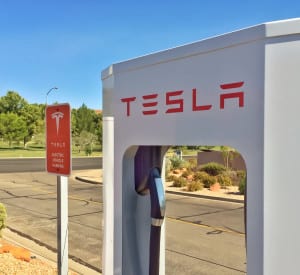
There is a designated route, from Los Angeles to Denver, that Telsa Motors has chosen as one of their inaugural routes to “pepper” with free superchargers. What is Supercharger? As Tesla Motors explains, they are free connectors that charge the Model S in minutes instead of hours. Stations are strategically placed to minimize stops during long-distance travel and are conveniently located near restaurants, shopping centers, and WiFi hot spots.
The Tesla Superchargers in St. George are in Sunset Plaza on the northwest corner of Bluff and Sunset. I noticed this installation about six months ago. Apparently it had already been in service for about six months. As explained, it is located in a shopping center near restaurants and hot spots. I’m sure you will recognize The Egg and I, Starbucks, Marv’s, and Gun Barrel. The Superchargers are locater across the road from The Egg and I’s parking lot.
Another Tesla Supercharger terminal is planned for Beaver. The LA to Denver route follows Interstate 15 and Interstate 70. Last week, I went by the Sunset Tesla Superchargers to get some photos for this article. Someone was charging a Tesla S. She had just started. The vehicle was 80 percent full in 30 minutes (the recommended charge for a Supercharger fill-up). The range for an 80 percent fill is about 170 miles. This is definitely enough to make the hop from Vegas to St. George or from St. George to Beaver.
In order for a Tesla model S to be able to utilize this network of Superchargers, there is a $2,500 factory-installed option to upgrade the car’s charging electronics. But the charging is free. There are already 512 Supercharger stations with 2,895 Superchargers. Many more are planned.
But wait! There’s more than Tesla Superchargers!
In addition to the Supercharger station, there are three “Destination Chargers” at the three Best Western hotels in town. Destination chargers do not supply the high current fast charging that a Supercharger does. They are similar to the 240 volt AC home chargers that completely recharge a Tesla in about 4 hours.
Tesla continues to innovate. In addition the the five variants of the model S sports sedan, next year brings the model X 7-seat SUV with gull-wing doors. There has also been an announcement of a $35K budget model in the works. There we have it! The return of the middle class. We will all be zooming around in Teslas.







On County Seat TV this morning they covered the rural energy conference recently held to cover energy development and challenges in Duchesne, Uinta and other energy-focused Utah counties. One comment was made about Tesla and the fact that people who drive Teslas should have bumper stickers on their cars supporting coal development since most of our electricity still comes from coal. Wow! Talk about turning that whole idea on its head! When these folks talk about educating the public, well one does have to wonder.
Hi Beacon. It is true that the carbon footprint of the all-electric Tesla is only as good as the power plant with regard to carbon emissions. However, please note that at 85 equivalent mpg, Teslas are sipping about 1/3 of a non-electric car. Then to, consider that the entire power grid for the country is now generated by less than 30% coal power plant output. Put those numbers together and the Tesla carbon footprint from coal seems to be quite low. That’s only going to improve as we keep taking coal plants out of service.
Bob, I certainly didn’t mean to imply that the comment made on the County Seat TV episode was valid, if that’s what you thought I meant. I meant that it just points to the type of thinking out there. When you have a group from the most oil/gas/coal producing counties in Utah talking about the future of energy in this state, what would you expect but some comments slamming any efforts to move away from that. I certainly agree with your position.
Bob, pretty good article with a couple of inaccuracies. Typical full up charge for MY Tesla 85D is 240 miles..or a range charge of 270 miles. But let’s take the 240 mile figure–then that’s 192 miles. But most of us when traveling and want the range DO charge to 270 miles if we want a little reserve. No sense in charging more than you need to the next charger. Some models don’t have this range..but the new ones have 5% MORE!
BTW, you guys are really lucky to be a part of the network. There’s quite a following and sometimes a bunch of Teslas will get together at these sites for a burger.
Now about energy and shifting the burden. I live in Lincoln, Nebraska and our local energy supplier Lincoln Electric System have been leaders in renewable energy including wind, hydro, and photovoltaics. In fact they are 48% renewable and even have enough left over to sell to other out of state consumers. And like someone else mentioned, the efficiency of an electric car is a whole lot MORE efficient than a gasoline powered car. Interesting fact, the energy stored in my 85KWH battery pack on my tesla is the equivalent of about 3 gallons of gas. So, I can go 270 miles on three gallons. And at breakneck speed BTW.
So there you go. My compliments on your picking up on the story and your VERY PRETTY website. All the best from Nebraska.
Dennis, yes I never even mentioned the acceleration. The high performance S variant can do 0-60 in less than 3 seconds. I’m thinking that is borderline wiplash territory. The acceleration is all about early torque in an electric motor versus late torque in a gas engine.
Bob, good article! I look forward to visiting St. George this fall when I get my Tesla Model X. I love Utah and can’t wait to get back for a visit! I feel compelled to address the concern that Beacon brought up about Tesla’s environmental impact.
I drive about 33,000 miles per year (140 mile daily round trip commute). I placed a deposit on my Model X shortly after it was announced in 2012. In 2013, I installed enough solar panels on my home to cover 33,000 miles of Model X electric-powered driving per year. My 2,200 sq ft home in Texas is relatively new and very energy efficient. I was already buying exclusively wind and solar power from the electric company so I really just purchased the solar panels to offset 100% of my projected driving requirements.
Although, I have not yet received my Model X, I have enjoyed paying an average electric bill of $35 per month for an all electric home. Based on comparable gasoline expenses alone, I will break even on the installation of solar on my home in less than 2 years! When my vehicle does arrive, all of my charging for my daily commute will be done at home from all renewable energy. Travelling anywhere else in the country, I will be able to charge for free at any of Tesla’s Supercharges.
I would also like to mention that Utah has recently offered tax incentive to draw more traditional dealerships into the state while remaining opposed to the sale of Tesla vehicles in Utah. Texas and Utah are 2 of only a handful of states that continue to fight Tesla sales on the grounds that Tesla selling directly to consumers violates state franchise laws. I would submit that this is not only counter to what is in the best interests of the consumer but it is also, ultimately, far worse on the environment than charging a Tesla with partially coal-generated electricity.
Tesla is working very hard to introduce the world to sustainable transportation and is VERY concerned about the environment. I had the choice of buying any vehicle available but between deciding to simply buying a car from any old car company OR purchasing a vehicle from a company that is committed to transforming transportation as we know it, the choice for me was quite simple.